Global Bio Marine Ingredients Market Forecast
- Bio marine ingredients market revenue to reach US$3.0 Bn in 2030, up from US$1.9 Bn recorded in 2023
- Market size expected to anticipated to expand at a CAGR of 6.5% between 2023 and 2030
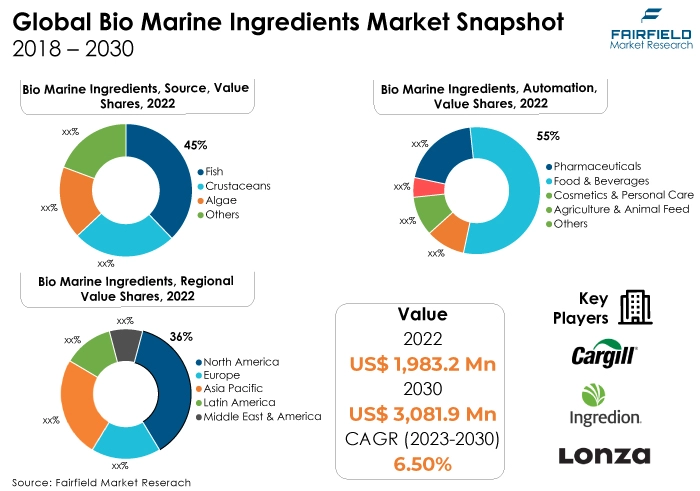
Quick Report Digest
- The key trend anticipated to fuel the bio marine ingredients market growth is the surge in customer desire for marine components' fat content and distinctive protein outside of their regular diets. Furthermore, the growing preference for organic products over conventional ones is responsible for the market's growth in the forecast period.
- Another major market trend expected to fuel the growth of the bio marine ingredients market is the increase in demand from food and beverage, and animal feed applications are expected further to buffer the expansion of the marine ingredients market.
- In 2023, the fish category dominated the industry. Fish are highly recognised as bio-marine because of their nutritional profile and high protein and omega-3 fatty acid content, especially EPA (eicosapentaenoic acid), and DHA (docosahexaenoic acid).
- In terms of market share for bio-marine ingredients globally, the proteins segment is anticipated to dominate. Fish, shellfish, and algae are some of the many sources of marine proteins. Protein bars, smoothies, and dietary supplements are just a few food and beverage products widely accepted by the population.
- In 2023, the food & beverages category controlled the market. As a diverse and sustainable source of nutrients and functional ingredients for the food and beverage sector, bio marine ingredients are becoming increasingly popular.
- The North American region is anticipated to account for the largest share of the global bio marine ingredients market, the rising consumer disposable income, the growing knowledge of the health advantages of bio marine ingredients, and the expanding desire for natural and sustainable ingredients.
- The market for bio-marine ingredients is expanding in the Asia Pacific due to an increasing understanding of the advantages of these organic and sustainable components. The region's consumers are willing to pay more for high-quality items since they are more interested in finding ones beneficial for their skin and hair.
A Look Back and a Look Forward - Comparative Analysis
The market for bio marine ingredients has grown in popularity due to factors such as the rising consumer disposable income, the growing interest in natural and sustainable ingredients, and the growing knowledge of the health advantages of marine ingredients.
The market witnessed staggered growth during the historical period 2018 – 2023. This is due to the differences in raw material availability. The availability of raw materials for bio-marine ingredients varies by ingredient type and location. Seaweed, for example, is a widely available raw resource in many regions of the world, whereas fish oil is more limited. However, the rising popularity of seafood and the growing need for sustainable and healthful components further boost the market demand.
There has been a surge in customer desire for marine components' fat content and distinctive protein outside of their regular diets. The market for marine ingredients is also expected to rise due to consumers' growing preference for organic products over conventional ones. Furthermore, the increasing demand from food and beverage and animal feed applications is anticipated to moderate the market expansion for marine components.
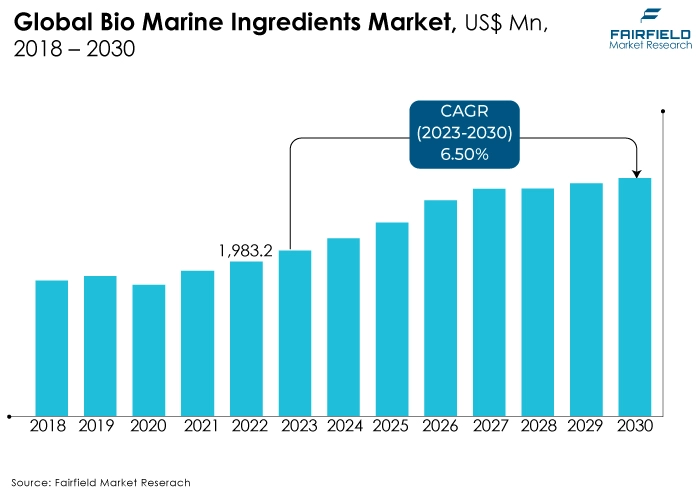
Key Growth Determinants
- Broadening Application Base in Animal Nutrition, and Pet Food
The growing usage of these substances in pet food and animal nutrition contributes to the bio-marine additives market boom. Numerous factors, such as growing knowledge of the health advantages of omega-3 fatty acids and other nutrients derived from marine sources for pets, are driving this trend. It has been demonstrated that omega-3 fatty acids improve heart health, skin and coat health, joint health, and cognitive function in animals.
In addition, the demand for high-quality pet food items is rising. More and more pet owners are prepared to spend extra on food they think will give their animals the healthiest possible diet. Marine foods are frequently regarded as premium ingredients because they are a great source of vital nutrients.
- Rising Boom Around Natural and Clean-Label Products
Demand for these organic and sustainable components is anticipated to increase further because the clean-label movement is not slowing down. To satisfy the demands of both producers and consumers, this offers a great opportunity for businesses that can supply premium, sustainably obtained bio-marine ingredients.
- Mounting Demand from Personal Care, Pharma, and Cosmetics
The market for bio-marine components is expanding rapidly because of the rising need for high-performing, eco-friendly, and natural chemicals in personal care, cosmetics, and pharmaceuticals. The multitude of advantages that these ingredients—which come from fish, seaweed, algae, and microorganisms—offer are drawing interest from both manufacturers and consumers.
For instance, marine collagen, derived from fish or jellyfish, is a potent humectant that draws and holds moisture onto the skin, making it an effective anti-ageing and moisturising agent. Additionally, it promotes collagen formation, giving the skin a younger, plumper appearance.
Major Growth Barriers
- Constraints on Supply
Certain supply constraints are affecting the growth of the biomarine ingredients market. Among these restrictions is the possibility of resource depletion and price volatility due to the overfishing of specific marine species utilised as biomarine components. Overfishing krill, a good source of omega-3 fatty acids, has been a big problem lately.
The range and abundance of marine species utilised as biomarine components are changing due to the effects of climate change on marine ecosystems. This may make it more challenging to supply certain substances reliably and sustainably. When plastics, chemicals, and other contaminants contaminate the oceans, marine animals become unfit for use as biomarine components.
- Unfavourable Weather Conditions
The marine environment is seriously threatened by climate change. Marine habitats suffer from rising sea temperatures, ocean acidity, and altered precipitation patterns. These changes may harm the growth and reproduction of marine creatures utilised to make biomarine components.
For instance, certain shellfish find it more difficult to develop their shells due to ocean acidification. They may become more vulnerable to illness and predators as a result. Additionally, acidification can stunt the growth of marine algae, which provide essential biomarine components like omega-3 fatty acids.
Key Trends and Opportunities to Look at
- Expansion of the Fishing and Marine Industry
The expansion of the fishing and marine sectors is intimately associated with the bio-marine ingredients market. Sustainable sourcing and processing methods are becoming increasingly necessary as the market for items generated from marine sources grows. As a result, cutting-edge technologies have been created to extract and use marine substances.
One example is biorefinery, which breaks down whole fish or other marine animals to extract different useful chemicals while minimising waste and optimising resource use. Enzymatic extraction produces cleaner and more effective extraction procedures using enzymes to break down marine material and release particular components. Algae-based ingredients: Cultivating algae is becoming more popular to meet the increasing demand because they are a sustainable source of several bio-marine compounds.
- Stepping up R&D Around Investigation of Potential Health Advantages
Extensive research and development (R&D) efforts have revealed the wealth of potential health advantages these compounds hold, leading to a spike in the market for bio-marine substances. Ocean bioactive substances, such as omega-3 fatty acids and marine collagen, have abundant applications in the nutraceutical, cosmeceutical, and functional food industries.
Studies on the special qualities of marine algae, such as macro- and microalgae, demonstrate their abundance in dietary fiber, antioxidants, and anti-inflammatory substances. These results facilitate the creation of innovative functional foods and nutraceuticals that target immune system function, gastrointestinal health, and cognitive function.
- Growing Significance of Sustainable Sourcing and Production Techniques
An increasing emphasis is being placed on the sustainable procurement of marine ingredients due to the growing knowledge of the negative environmental effects of traditional fishing methods. This entails investing in aquaculture, adopting ethical fishing methods, employing wastes from the seafood business, and leveraging cutting-edge extraction technology to reduce waste.
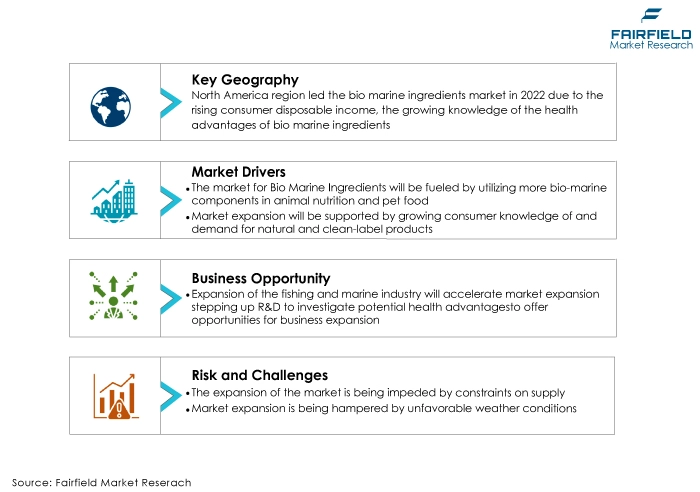
How Does the Regulatory Scenario Shape this Industry?
Depending on the nation or location, the regulatory environment for biomarine components can be complicated. Chemicals used in biomarines often have to adhere to the same safety and quality requirements as those used in food and cosmetics. Still, a few more rules are unique to biomarine components.
Biomarine elements, for instance, need to be included in the Annex I list of approved innovative foods in the European Union. If biomarine compounds have been used in food for a long time without causing problems, they are often considered safe (GRAS) in the US. Regulating bodies, including the Marine Mammal Protection Act and the Mercury Standards, have specific rules governing some biomarine components.
Fairfield’s Ranking Board
Top Segments
- Fish Category Continues to Dominate over Other Segments
The fish segment dominated the market in 2023. High-protein ingredients like fish meal are utilised in animal feed, especially for aquaculture and poultry. With fish oil making up almost 25% of the marine protein market, it is the second largest segment overall. Omega-3 fatty acids are vital to human health and abundant in fish oil.
Furthermore, the algae category is projected to experience the fastest market growth. Though it is currently in its infancy, the market for bio-marine components derived from algae has the potential to grow significantly. It is anticipated that demand for algae-based biomarine components will increase as people learn more about the health advantages of algae and as technology for collecting and processing algae advances.
- Protein to Surge Ahead Through 2030
In 2023, the protein category dominated the industry. Various food and beverage products can incorporate biomarine proteins, an extremely versatile component. Additionally, they are an excellent source of important nutrients, including omega-3 fatty acids.
The omega-3 fatty acids category is anticipated to grow substantially throughout the projected period. Essential to human health are omega-3 fatty acids, a subtype of polyunsaturated fatty acids. Flaxseed and chia seeds are two plant sources that contain them, along with oily fish like mackerel, salmon, and tuna. Studies have demonstrated that omega-3 fatty acids help lower the incidence of heart disease, stroke, and cancer, among other health issues.
- Food & Beverages Expected to Retain the Lead
The food & beverages segment dominated the market in 2023. As consumers seek natural sources of Omega-3 fatty acids, antioxidants, and other nutrients, nutritional supplements are a primary driver of growth in this category. Biomarine elements are also finding an increasing market in seafood products, where processors use them to improve their products' texture, flavor, and nutritional value.
Biomarine components are increasingly used to provide flavor and functionality to processed foods such as soups, sauces, and snacks. The cosmetics & personal care category is expected to experience the fastest growth within the forecast time frame.
The industry has grown because to the widespread usage of VCO hair and skin care products because of its moisturising, antimicrobial, and cleaning properties. This oil's moisturising properties and capacity to deeply permeate the skin have led to its growing use in cosmetics as a highlighter, lip gloss, and make-up primer.
Regional Frontrunners
The US Underpins North America’s Top Rank in Supplement Consumption
A growing trend of supplement consumption benefits the US market and is anticipated to dominate in the North American region. The Council for Responsible Nutrition (CRN) found that 52% of consumers take specialised supplements that include melatonin, omega-3 fatty acids, and probiotics. Fibre is the most often ingested of them.
As the demand for marine collagen, peptides, and Omega-3 fatty acids rises in the US, this trend of supplying nutrition externally through supplements is driving up sales of pharmaceuticals and the nutraceutical industry in the US. It also positively affects the sales of biomarine ingredients.
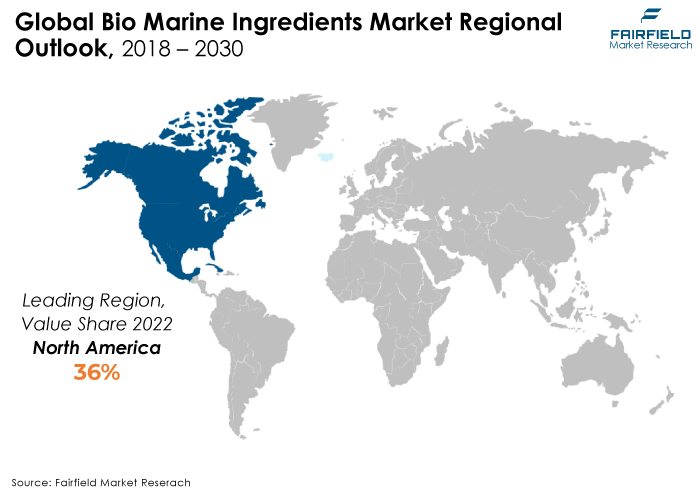
Asia Pacific’s Appetite for Bio Marine Ingredients on the Rise
The increase in the food and beverages, pharmaceutical, and cosmetics industries is expanding the Asia Pacific bio marine ingredients market. Asia Pacific is The most populous region globally, home to some of the world's largest economies, including those of China, India, Japan, Australia, and New Zealand.
The expanding government investment in the fishing industry throughout the Asia Pacific region is expected to generate significant development prospects for the industry. For example, the Indian government recently unveiled The Pradhan Mantri Matsya Sampada Yojana (PMMSY), a new flagship initiative with a massive investment of US$2.46 Bn for the growth and expansion of the nation's fisheries industry.
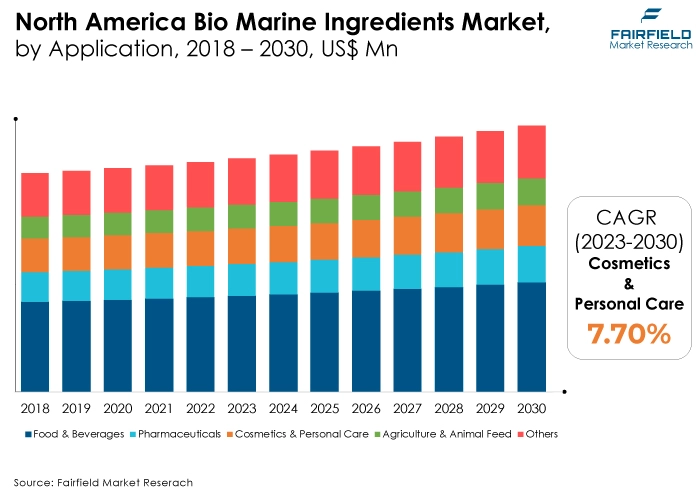
Who are the Leaders in Global Bio Marine Ingredients Space?
- Aker BioMarine AS
- Cargill, Incorporated
- Ingredion Incorporated
- Lonza Group AG
- Seagarden AS
- Symrise AG
- Tate & Lyle PLC
- CP Kelco USA, Inc.
- FMC Corporation
- Givaudan SAl
Significant Company Developments
New Product Launch
- In 2022: Two novel cosmetic active compounds from brown seaweed, RonaCare JouvaMer and RonaCare ReviMer, were introduced by Merck. These chemicals are supposed to have moisturising and anti-ageing properties.
- In 2022: Seppic has introduced a novel marine collagen ingredient called SepicalTM M3. This substance is sourced from the collagen of the regenerating Turritopsis dohrnii jellyfish.
- In 2022, A new marine omega-3 oil was introduced by DSM. The brain's health depends on the omega-3 fatty acid docosahexaenoic acid (DHA). A sustainable source of DHA, microalgae is the source of DSM's new oil.
Distribution Agreement
- In 2020: A US$5.9 Mn investment was recently made in Bio-Marine Ingredients Ireland, a biotech company that supplies fish extracts for food and animal feed. The extracts include lipids, proteins, and calcium.
- In 2020: Algaia, a French bio-marine ingredient firm specialising in natural extracts from seaweed, recently completed a US$2.4 million investment round that it claims it will utilise to create novel seaweed-based solutions that could lead to plant-based substitutes.
An Expert’s Eye
Demand and Future Growth
Fairfield’s Analysis shows that marine additives are a fantastic complement to the natural and sustainable products consumers are increasingly seeking. They appeal to customers who care about the environment because they are healthy and frequently sourced from sustainable sources.
Furthermore, bioactive substances, including collagen, antioxidants, and omega-3 fatty acids, are abundant in bio-marine components. These have several advantages, such as enhancing joint health, heart health, and cognitive function. This motivates their use in various sectors, including pharmaceuticals, food and drink, nutraceuticals, and cosmetics.
Supply Side of the Market
According to our analysis, the identification of biomarine components, such as collagen, as functional biomaterials with medicinal applications has been made possible by recent breakthroughs in biotechnology. For example, the medical field has revolutionised due to the enormous potential of collagen and its peptides, particularly in orthopedics, ophthalmology, surgery, and dentistry.
It is also utilised in cosmetics as a natural humectant, moisturizer, anti-ageing, and anti-wrinkling substance. The International Agency for Research on Cancer (IARC) of the World Health Organisation reports that there were 19.29 million new instances of cancer globally in 2020. That number is expected to rise to 27 million by 2040, with 9.96 million deaths.
Global Bio Marine Ingredients Market is Segmented as Below:
By Source:
- Fish
- Crustaceans
- Algae
- Others
By Type:
- Proteins
- Peptides
- Collagens
- Chitosan
- Omega-3 Fatty Acids
- Polysaccharides
- Others
By Application:
- Food & Beverages
- Pharmaceuticals
- Cosmetics & Personal Care
- Agriculture & Animal Feed
- Others
By Geographic Coverage:
- North America
- U.S.
- Canada
- Europe
- Germany
- U.K.
- France
- Italy
- Turkey
- Russia
- Rest of Europe
- Asia Pacific
- China
- Japan
- South Korea
- India
- Southeast Asia
- Rest of Asia Pacific
- Latin America
- Brazil
- Mexico
- Argentina
- Rest of Latin America
- Middle East & Africa
- GCC
- South Africa
- Egypt
- Nigeria
- Rest of Middle East & Africa
1. Executive Summary
1.1. Global Bio Marine Ingredients Market Snapshot
1.2. Future Projections
1.3. Key Market Trends
1.4. Regional Snapshot, by Value, 2022
1.5. Analyst Recommendations
2. Market Overview
2.1. Market Definitions and Segmentations
2.2. Market Dynamics
2.2.1. Drivers
2.2.2. Restraints
2.2.3. Market Opportunities
2.3. Value Chain Analysis
2.4. Porter’s Five Forces Analysis
2.5. COVID-19 Impact Analysis
2.5.1. Supply
2.5.2. Demand
2.6. Impact of Ukraine-Russia Conflict
2.7. Economic Overview
2.7.1. World Economic Projections
2.8. PESTLE Analysis
3. Global Bio Marine Ingredients Market Outlook, 2018 - 2030
3.1. Global Bio Marine Ingredients Market Outlook, by Source, Value (US$ Mn), 2018 - 2030
3.1.1. Key Highlights
3.1.1.1. Fish
3.1.1.2. Crustaceans
3.1.1.3. Algae
3.1.1.4. Others
3.2. Global Bio Marine Ingredients Market Outlook, by Type, Value (US$ Mn), 2018 - 2030
3.2.1. Key Highlights
3.2.1.1. Proteins
3.2.1.2. Peptides
3.2.1.3. Collagens
3.2.1.4. Chitosan
3.2.1.5. Omega-3 Fatty Acids
3.2.1.6. Polysaccharides
3.2.1.7. Others
3.3. Global Bio Marine Ingredients Market Outlook, by Application, Value (US$ Mn), 2018 - 2030
3.3.1. Key Highlights
3.3.1.1. Food & Beverages
3.3.1.2. Pharmaceuticals
3.3.1.3. Cosmetics & Personal Care
3.3.1.4. Agriculture & Animal Feed
3.3.1.5. Others
3.4. Global Bio Marine Ingredients Market Outlook, by Region, Value (US$ Mn), 2018 - 2030
3.4.1. Key Highlights
3.4.1.1. North America
3.4.1.2. Europe
3.4.1.3. Asia Pacific
3.4.1.4. Latin America
3.4.1.5. Middle East & Africa
4. North America Bio Marine Ingredients Market Outlook, 2018 - 2030
4.1. North America Bio Marine Ingredients Market Outlook, by Source, Value (US$ Mn), 2018 - 2030
4.1.1. Key Highlights
4.1.1.1. Fish
4.1.1.2. Crustaceans
4.1.1.3. Algae
4.1.1.4. Others
4.2. North America Bio Marine Ingredients Market Outlook, by Type, Value (US$ Mn), 2018 - 2030
4.2.1. Key Highlights
4.2.1.1. Proteins
4.2.1.2. Peptides
4.2.1.3. Collagens
4.2.1.4. Chitosan
4.2.1.5. Omega-3 Fatty Acids
4.2.1.6. Polysaccharides
4.2.1.7. Others
4.3. North America Bio Marine Ingredients Market Outlook, by Application, Value (US$ Mn), 2018 - 2030
4.3.1. Key Highlights
4.3.1.1. Food & Beverages
4.3.1.2. Pharmaceuticals
4.3.1.3. Cosmetics & Personal Care
4.3.1.4. Agriculture & Animal Feed
4.3.1.5. Others
4.3.2. BPS Analysis/Market Attractiveness Analysis
4.4. North America Bio Marine Ingredients Market Outlook, by Country, Value (US$ Mn), 2018 - 2030
4.4.1. Key Highlights
4.4.1.1. U.S. Bio Marine Ingredients Market by Source, Value (US$ Mn), 2018 - 2030
4.4.1.2. U.S. Bio Marine Ingredients Market Type, Value (US$ Mn), 2018 - 2030
4.4.1.3. U.S. Bio Marine Ingredients Market Application, Value (US$ Mn), 2018 - 2030
4.4.1.4. Canada Bio Marine Ingredients Market by Source, Value (US$ Mn), 2018 - 2030
4.4.1.5. Canada Bio Marine Ingredients Market Type, Value (US$ Mn), 2018 - 2030
4.4.1.6. Canada Bio Marine Ingredients Market Application, Value (US$ Mn), 2018 - 2030
4.4.2. BPS Analysis/Market Attractiveness Analysis
5. Europe Bio Marine Ingredients Market Outlook, 2018 - 2030
5.1. Europe Bio Marine Ingredients Market Outlook, by Source, Value (US$ Mn), 2018 - 2030
5.1.1. Key Highlights
5.1.1.1. Fish
5.1.1.2. Crustaceans
5.1.1.3. Algae
5.1.1.4. Others
5.2. Europe Bio Marine Ingredients Market Outlook, by Type, Value (US$ Mn), 2018 - 2030
5.2.1. Key Highlights
5.2.1.1. Proteins
5.2.1.2. Peptides
5.2.1.3. Collagens
5.2.1.4. Chitosan
5.2.1.5. Omega-3 Fatty Acids
5.2.1.6. Polysaccharides
5.2.1.7. Others
5.3. Europe Bio Marine Ingredients Market Outlook, by Application, Value (US$ Mn), 2018 - 2030
5.3.1. Key Highlights
5.3.1.1. Food & Beverages
5.3.1.2. Pharmaceuticals
5.3.1.3. Cosmetics & Personal Care
5.3.1.4. Agriculture & Animal Feed
5.3.1.5. Others
5.3.2. BPS Analysis/Market Attractiveness Analysis
5.4. Europe Bio Marine Ingredients Market Outlook, by Country, Value (US$ Mn), 2018 - 2030
5.4.1. Key Highlights
5.4.1.1. Germany Bio Marine Ingredients Market by Source, Value (US$ Mn), 2018 - 2030
5.4.1.2. Germany Bio Marine Ingredients Market Type, Value (US$ Mn), 2018 - 2030
5.4.1.3. Germany Bio Marine Ingredients Market Application, Value (US$ Mn), 2018 - 2030
5.4.1.4. U.K. Bio Marine Ingredients Market by Source, Value (US$ Mn), 2018 - 2030
5.4.1.5. U.K. Bio Marine Ingredients Market Type, Value (US$ Mn), 2018 - 2030
5.4.1.6. U.K. Bio Marine Ingredients Market Application, Value (US$ Mn), 2018 - 2030
5.4.1.7. France Bio Marine Ingredients Market by Source, Value (US$ Mn), 2018 - 2030
5.4.1.8. France Bio Marine Ingredients Market Type, Value (US$ Mn), 2018 - 2030
5.4.1.9. France Bio Marine Ingredients Market Application, Value (US$ Mn), 2018 - 2030
5.4.1.10. Italy Bio Marine Ingredients Market by Source, Value (US$ Mn), 2018 - 2030
5.4.1.11. Italy Bio Marine Ingredients Market Type, Value (US$ Mn), 2018 - 2030
5.4.1.12. Italy Bio Marine Ingredients Market Application, Value (US$ Mn), 2018 - 2030
5.4.1.13. Turkey Bio Marine Ingredients Market by Source, Value (US$ Mn), 2018 - 2030
5.4.1.14. Turkey Bio Marine Ingredients Market Type, Value (US$ Mn), 2018 - 2030
5.4.1.15. Turkey Bio Marine Ingredients Market Application, Value (US$ Mn), 2018 - 2030
5.4.1.16. Russia Bio Marine Ingredients Market by Source, Value (US$ Mn), 2018 - 2030
5.4.1.17. Russia Bio Marine Ingredients Market Type, Value (US$ Mn), 2018 - 2030
5.4.1.18. Russia Bio Marine Ingredients Market Application, Value (US$ Mn), 2018 - 2030
5.4.1.19. Rest of Europe Bio Marine Ingredients Market by Source, Value (US$ Mn), 2018 - 2030
5.4.1.20. Rest of Europe Bio Marine Ingredients Market Type, Value (US$ Mn), 2018 - 2030
5.4.1.21. Rest of Europe Bio Marine Ingredients Market Application, Value (US$ Mn), 2018 - 2030
5.4.2. BPS Analysis/Market Attractiveness Analysis
6. Asia Pacific Bio Marine Ingredients Market Outlook, 2018 - 2030
6.1. Asia Pacific Bio Marine Ingredients Market Outlook, by Source, Value (US$ Mn), 2018 - 2030
6.1.1. Key Highlights
6.1.1.1. Fish
6.1.1.2. Crustaceans
6.1.1.3. Algae
6.1.1.4. Others
6.2. Asia Pacific Bio Marine Ingredients Market Outlook, by Type, Value (US$ Mn), 2018 - 2030
6.2.1. Key Highlights
6.2.1.1. Proteins
6.2.1.2. Peptides
6.2.1.3. Collagens
6.2.1.4. Chitosan
6.2.1.5. Omega-3 Fatty Acids
6.2.1.6. Polysaccharides
6.2.1.7. Others
6.3. Asia Pacific Bio Marine Ingredients Market Outlook, by Application, Value (US$ Mn), 2018 - 2030
6.3.1. Key Highlights
6.3.1.1. Food & Beverages
6.3.1.2. Pharmaceuticals
6.3.1.3. Cosmetics & Personal Care
6.3.1.4. Agriculture & Animal Feed
6.3.1.5. Others
6.3.2. BPS Analysis/Market Attractiveness Analysis
6.4. Asia Pacific Bio Marine Ingredients Market Outlook, by Country, Value (US$ Mn), 2018 - 2030
6.4.1. Key Highlights
6.4.1.1. China Bio Marine Ingredients Market by Source, Value (US$ Mn), 2018 - 2030
6.4.1.2. China Bio Marine Ingredients Market Type, Value (US$ Mn), 2018 - 2030
6.4.1.3. China Bio Marine Ingredients Market Application, Value (US$ Mn), 2018 - 2030
6.4.1.4. Japan Bio Marine Ingredients Market by Source, Value (US$ Mn), 2018 - 2030
6.4.1.5. Japan Bio Marine Ingredients Market Type, Value (US$ Mn), 2018 - 2030
6.4.1.6. Japan Bio Marine Ingredients Market Application, Value (US$ Mn), 2018 - 2030
6.4.1.7. South Korea Bio Marine Ingredients Market by Source, Value (US$ Mn), 2018 - 2030
6.4.1.8. South Korea Bio Marine Ingredients Market Type, Value (US$ Mn), 2018 - 2030
6.4.1.9. South Korea Bio Marine Ingredients Market Application, Value (US$ Mn), 2018 - 2030
6.4.1.10. India Bio Marine Ingredients Market by Source, Value (US$ Mn), 2018 - 2030
6.4.1.11. India Bio Marine Ingredients Market Type, Value (US$ Mn), 2018 - 2030
6.4.1.12. India Bio Marine Ingredients Market Application, Value (US$ Mn), 2018 - 2030
6.4.1.13. Southeast Asia Bio Marine Ingredients Market by Source, Value (US$ Mn), 2018 - 2030
6.4.1.14. Southeast Asia Bio Marine Ingredients Market Type, Value (US$ Mn), 2018 - 2030
6.4.1.15. Southeast Asia Bio Marine Ingredients Market Application, Value (US$ Mn), 2018 - 2030
6.4.1.16. Rest of Asia Pacific Bio Marine Ingredients Market by Source, Value (US$ Mn), 2018 - 2030
6.4.1.17. Rest of Asia Pacific Bio Marine Ingredients Market Type, Value (US$ Mn), 2018 - 2030
6.4.1.18. Rest of Asia Pacific Bio Marine Ingredients Market Application, Value (US$ Mn), 2018 - 2030
6.4.2. BPS Analysis/Market Attractiveness Analysis
7. Latin America Bio Marine Ingredients Market Outlook, 2018 - 2030
7.1. Latin America Bio Marine Ingredients Market Outlook, by Source, Value (US$ Mn), 2018 - 2030
7.1.1. Key Highlights
7.1.1.1. Fish
7.1.1.2. Crustaceans
7.1.1.3. Algae
7.1.1.4. Others
7.2. Latin America Bio Marine Ingredients Market Outlook, by Type, Value (US$ Mn), 2018 - 2030
7.2.1. Key Highlights
7.2.1.1. Proteins
7.2.1.2. Peptides
7.2.1.3. Collagens
7.2.1.4. Chitosan
7.2.1.5. Omega-3 Fatty Acids
7.2.1.6. Polysaccharides
7.2.1.7. Others
7.3. Latin America Bio Marine Ingredients Market Outlook, by Application, Value (US$ Mn), 2018 - 2030
7.3.1. Key Highlights
7.3.1.1. Food & Beverages
7.3.1.2. Pharmaceuticals
7.3.1.3. Cosmetics & Personal Care
7.3.1.4. Agriculture & Animal Feed
7.3.1.5. Others
7.3.2. BPS Analysis/Market Attractiveness Analysis
7.4. Latin America Bio Marine Ingredients Market Outlook, by Country, Value (US$ Mn), 2018 - 2030
7.4.1. Key Highlights
7.4.1.1. Brazil Bio Marine Ingredients Market by Source, Value (US$ Mn), 2018 - 2030
7.4.1.2. Brazil Bio Marine Ingredients Market Type, Value (US$ Mn), 2018 - 2030
7.4.1.3. Brazil Bio Marine Ingredients Market Application, Value (US$ Mn), 2018 - 2030
7.4.1.4. Mexico Bio Marine Ingredients Market by Source, Value (US$ Mn), 2018 - 2030
7.4.1.5. Mexico Bio Marine Ingredients Market Type, Value (US$ Mn), 2018 - 2030
7.4.1.6. Mexico Bio Marine Ingredients Market Application, Value (US$ Mn), 2018 - 2030
7.4.1.7. Argentina Bio Marine Ingredients Market by Source, Value (US$ Mn), 2018 - 2030
7.4.1.8. Argentina Bio Marine Ingredients Market Type, Value (US$ Mn), 2018 - 2030
7.4.1.9. Argentina Bio Marine Ingredients Market Application, Value (US$ Mn), 2018 - 2030
7.4.1.10. Rest of Latin America Bio Marine Ingredients Market by Source, Value (US$ Mn), 2018 - 2030
7.4.1.11. Rest of Latin America Bio Marine Ingredients Market Type, Value (US$ Mn), 2018 - 2030
7.4.1.12. Rest of Latin America Bio Marine Ingredients Market Application, Value (US$ Mn), 2018 - 2030
7.4.2. BPS Analysis/Market Attractiveness Analysis
8. Middle East & Africa Bio Marine Ingredients Market Outlook, 2018 - 2030
8.1. Middle East & Africa Bio Marine Ingredients Market Outlook, by Source, Value (US$ Mn), 2018 - 2030
8.1.1. Key Highlights
8.1.1.1. Fish
8.1.1.2. Crustaceans
8.1.1.3. Algae
8.1.1.4. Others
8.2. Middle East & Africa Bio Marine Ingredients Market Outlook, by Type, Value (US$ Mn), 2018 - 2030
8.2.1. Key Highlights
8.2.1.1. Proteins
8.2.1.2. Peptides
8.2.1.3. Collagens
8.2.1.4. Chitosan
8.2.1.5. Omega-3 Fatty Acids
8.2.1.6. Polysaccharides
8.2.1.7. Others
8.3. Middle East & Africa Bio Marine Ingredients Market Outlook, by Application, Value (US$ Mn), 2018 - 2030
8.3.1. Key Highlights
8.3.1.1. Food & Beverages
8.3.1.2. Pharmaceuticals
8.3.1.3. Cosmetics & Personal Care
8.3.1.4. Agriculture & Animal Feed
8.3.1.5. Others
8.3.2. BPS Analysis/Market Attractiveness Analysis
8.4. Middle East & Africa Bio Marine Ingredients Market Outlook, by Country, Value (US$ Mn), 2018 - 2030
8.4.1. Key Highlights
8.4.1.1. GCC Bio Marine Ingredients Market by Source, Value (US$ Mn), 2018 - 2030
8.4.1.2. GCC Bio Marine Ingredients Market Type, Value (US$ Mn), 2018 - 2030
8.4.1.3. GCC Bio Marine Ingredients Market Application, Value (US$ Mn), 2018 - 2030
8.4.1.4. South Africa Bio Marine Ingredients Market by Source, Value (US$ Mn), 2018 - 2030
8.4.1.5. South Africa Bio Marine Ingredients Market Type, Value (US$ Mn), 2018 - 2030
8.4.1.6. South Africa Bio Marine Ingredients Market Application, Value (US$ Mn), 2018 - 2030
8.4.1.7. Egypt Bio Marine Ingredients Market by Source, Value (US$ Mn), 2018 - 2030
8.4.1.8. Egypt Bio Marine Ingredients Market Type, Value (US$ Mn), 2018 - 2030
8.4.1.9. Egypt Bio Marine Ingredients Market Application, Value (US$ Mn), 2018 - 2030
8.4.1.10. Nigeria Bio Marine Ingredients Market by Source, Value (US$ Mn), 2018 - 2030
8.4.1.11. Nigeria Bio Marine Ingredients Market Type, Value (US$ Mn), 2018 - 2030
8.4.1.12. Nigeria Bio Marine Ingredients Market Application, Value (US$ Mn), 2018 - 2030
8.4.1.13. Rest of Middle East & Africa Bio Marine Ingredients Market by Source, Value (US$ Mn), 2018 - 2030
8.4.1.14. Rest of Middle East & Africa Bio Marine Ingredients Market Type, Value (US$ Mn), 2018 - 2030
8.4.1.15. Rest of Middle East & Africa Bio Marine Ingredients Market Application, Value (US$ Mn), 2018 - 2030
8.4.2. BPS Analysis/Market Attractiveness Analysis
9. Competitive Landscape
9.1. Application vs Application Heatmap
9.2. Manufacturer vs Application Heatmap
9.3. Company Market Share Analysis, 2022
9.4. Competitive Dashboard
9.5. Company Profiles
9.5.1. Aker BioMarine AS
9.5.1.1. Company Overview
9.5.1.2. Product Portfolio
9.5.1.3. Financial Overview
9.5.1.4. Business Strategies and Development
9.5.2. Cargill, Incorporated
9.5.2.1. Company Overview
9.5.2.2. Product Portfolio
9.5.2.3. Financial Overview
9.5.2.4. Business Strategies and Development
9.5.3. Ingredion Incorporated
9.5.3.1. Company Overview
9.5.3.2. Product Portfolio
9.5.3.3. Financial Overview
9.5.3.4. Business Strategies and Development
9.5.4. Lonza Group AG
9.5.4.1. Company Overview
9.5.4.2. Product Portfolio
9.5.4.3. Financial Overview
9.5.4.4. Business Strategies and Development
9.5.5. Seagarden AS
9.5.5.1. Company Overview
9.5.5.2. Product Portfolio
9.5.5.3. Financial Overview
9.5.5.4. Business Strategies and Development
9.5.6. Symrise AG
9.5.6.1. Company Overview
9.5.6.2. Product Portfolio
9.5.6.3. Financial Overview
9.5.6.4. Business Strategies and Development
9.5.7. Tate & Lyle PLC
9.5.7.1. Company Overview
9.5.7.2. Product Portfolio
9.5.7.3. Financial Overview
9.5.7.4. Business Strategies and Development
9.5.8. CP Kelco USA, Inc.
9.5.8.1. Company Overview
9.5.8.2. Product Portfolio
9.5.8.3. Business Strategies and Development
9.5.9. FMC Corporation
9.5.9.1. Company Overview
9.5.9.2. Product Portfolio
9.5.9.3. Financial Overview
9.5.9.4. Business Strategies and Development
9.5.10. Givaudan SA
9.5.10.1. Company Overview
9.5.10.2. Product Portfolio
9.5.10.3. Financial Overview
9.5.10.4. Business Strategies and Development
10. Appendix
10.1. Research Methodology
10.2. Report Assumptions
10.3. Acronyms and Abbreviations
|
BASE YEAR |
HISTORICAL DATA |
FORECAST PERIOD |
UNITS |
|||
|
2022 |
|
2018 - 2022 |
2023 - 2030 |
Value: US$ Million |
||
|
REPORT FEATURES |
DETAILS |
|
Source Coverage |
|
|
Type Coverage |
|
|
Application Coverage |
|
|
Geographical Coverage |
|
|
Leading Companies |
|
|
Report Highlights |
Key Market Indicators, Macro-micro economic impact analysis, Technological Roadmap, Key Trends, Driver, Restraints, and Future Opportunities & Revenue Pockets, Porter’s 5 Forces Analysis, Historical Trend (2019-2021), Market Estimates and Forecast, Market Dynamics, Industry Trends, Competition Landscape, Category, Region, Country-wise Trends & Analysis, COVID-19 Impact Analysis (Demand and Supply Chain) |
